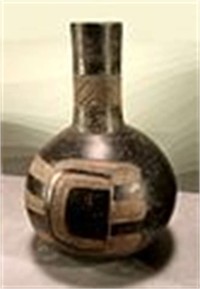Facts about Olmec

The mythological figure of the feathered or plumed serpent depicted throughout North America and Mesoamerica probably originated in Olmec times.

Despite their size, San Lorenzo and La Venta were largely ceremonial centers, and the vast majority of the Olmec lived in villages similar to present-day villages and hamlets in Tabasco and Veracruz.

Olmec artforms remain in works of both monumental statuary and small jade work.

Part of the problem is the lack of materials and understanding of the Olmec civilization.

The Long Count calendar used by many subsequent Mesoamerican civilizations, as well as the concept of zero, may have been devised by the Olmec.
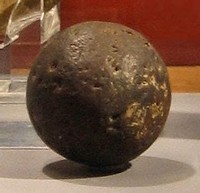
The Olmec were likely the originators of the Mesoamerican ballgame so prevalent among later cultures of the region and used for recreational and religious purposes.

Olmec culture was unknown to historians until the mid-nineteenth century.

Matthew Stirling of the Smithsonian Institution conducted the first detailed scientific excavations of Olmec sites in the 1930s and 1940s.

Some Olmec art, however, is surprisingly naturalistic, displaying an accuracy of depiction of human anatomy perhaps equaled in the pre-Columbian New World only by the best Maya Classic era art.

Perhaps the best-recognized Olmec artforms are their enormous helmeted heads.
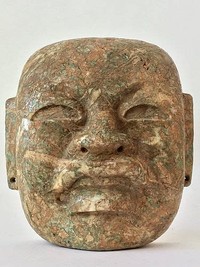
The Olmec were an ancient Pre-Colombian people living in the tropical lowlands of south-central Mexico, roughly in what are the modern-day states of Veracruz and Tabasco on the Isthmus of Tehuantepec.

Art and iconography clearly demonstrate the importance of the Feathered Serpent Deity in Classic era as well as Olmec art.
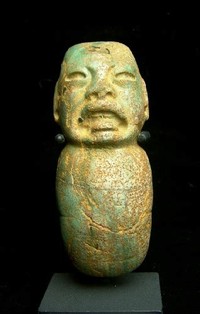
The Olmec carved items from fine jade and jadeite, including many human figures with strong jaguar features.

The argument that the Olmec instituted human sacrifice is significantly more speculative.

Among the Olmec, gods are often depicted with a distinct cleft on the forehead, perhaps identifying this characteristic as divine.

Whatever the cause, within a few hundred years of the abandonment of the last Olmec cities, successor cultures had become firmly established.

Olmec figurines are also found abundantly in sites throughout the Formative Period.
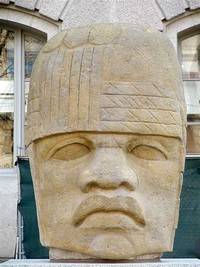
No other Olmec heartland site comes close to these in terms of size or in quantity and quality of architecture and sculpture.

Stirling, along with art historian Miguel Covarrubias, became convinced that the Olmec predated most other known Mesoamerican civilizations.

In 1862 the fortuitous discovery of a colossal head near Tres Zapotes, Veracruz by Josй Melgar y Serrano marked the first significant rediscovery of Olmec artifacts.

Olmec history originated at its base within San Lorenzo Tenochtitlбn, where distinctively Olmec features begin to emerge before 1200 B.C.E.

Some researchers, including artist and art historian Miguel Covarrubias, have even postulated that the Olmec formulated the forerunners of many of the later Mesoamerican deities.

Still, much of their culture remains and the Olmec are credited (at least speculatively) with many innovations in Mesoamerica, including writing, the calendar using zero, and the Mesoamerican ballgame prevalent in the region.

The Olmec image of the rain spirit appears frequently in the mythology of succeeding cultures.

population in the eastern half of the Olmec heartland dropped precipitously, and the area remained sparsely inhabited until the nineteenth century.

Numerous natural and ceramic stingray spikes and maguey thorns have been found in the archaeological record of the Olmec heartland.

Debate as to whether the Olmec were the originating culture in Latin and South America soon began.

Following the decline of San Lorenzo, La Venta became the most prominent Olmec center, lasting from 900 B.C.E.

Little is directly known about the societal or political structure of Olmec society.
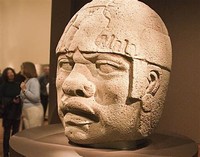
An exhibition in Mexico which included both Egyptian and Olmec artifacts revealed cultural parallels in religion, architecture, and the arts, supporting such speculation.
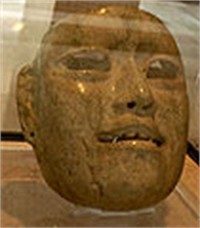
The Olmec heartland, for example, shows considerable centralization, first at San Lorenzo and then at La Venta.

The Olmec are credited, or speculatively credited, with many "firsts" in Mesoamerican civilization, including the Mesoamerican ballgame, bloodletting and perhaps human sacrifice, writing and epigraphy, and the invention of zero and the Mesoamerican calendar.
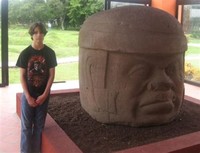
The Tres Zapotes site, on the western edge of the Olmec heartland, continued to be occupied well past 400 B.C.E., but without the hallmarks of the Olmec culture.

Olmec art shows that such deities as the Feathered Serpent, a Man of Crops, and the Rain Spirit were already in the Mesoamerican pantheon in Olmec times.
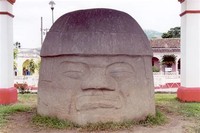
Based on studies of two villages in the Tuxtlas Mountains, maize cultivation became increasingly important to the Olmec diet over time, although the diet remained fairly diverse.

The Olmec heartland is characterized by swampy lowlands punctuated by low hills, ridges, and volcanoes.
